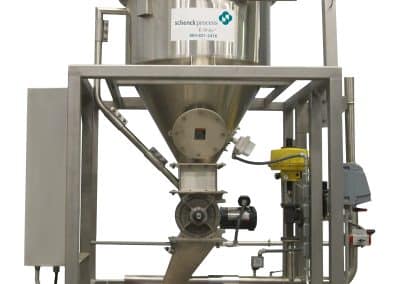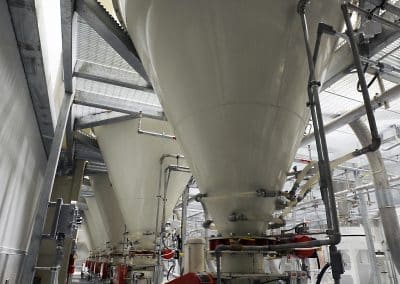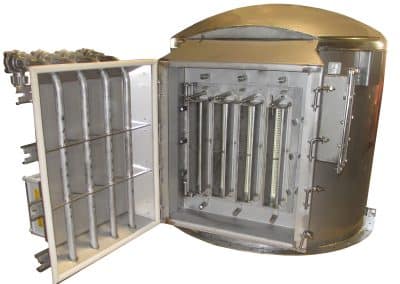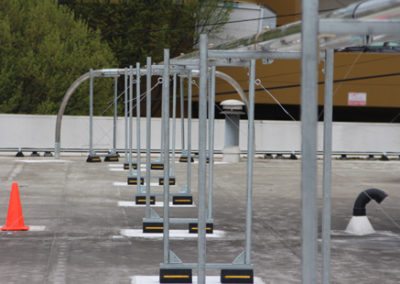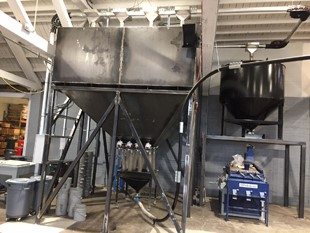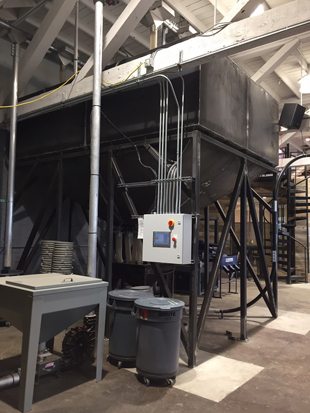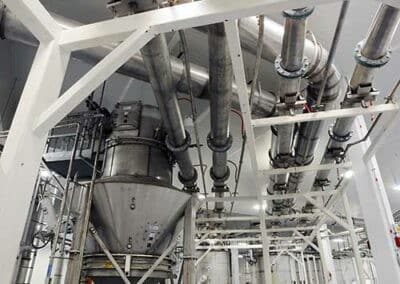Pneumatic Conveyors
Pneumatic conveyors use pressurized air (CO2 or nitrogen can be used to keep temperatures low) to move materials through a pipeline. This type of conveying system is widely used in a variety of industries, including chemical, pharmaceutical, food processing, coffee roasting, and minerals processing, and others.
| Make |
Application-Dependent
|
| Model | Move Master, E-Finity, Custom |
| Throughputs | Up to ~1,100 lbs./hr |
| Made In | Europe/USA |
There are several factors to consider when deciding whether to use pneumatic conveying for a particular application:
- Material characteristics: Pneumatic conveying is most suitable for dry, free-flowing materials, such as powders, granules, and flakes. It is not typically suitable for wet or sticky materials.
- Conveying distance: Pneumatic conveying is generally more efficient for shorter conveying distances, as the pressure required to move the material through the pipeline increases with distance. As a reference, ABM pneumatic solutions are viable at volumes up to about 1100 lbs./hr. at a distance of up to about 330 ft.
- Material handling requirements: Pneumatic conveying can be an effective solution for materials that are difficult to handle manually or mechanically, such as abrasive or fragile materials.
- Safety considerations: Pneumatic conveying can be a safer option for handling hazardous materials, as it eliminates the need for manual handling and can minimize the risk of dust explosions.
- Environmental considerations: Pneumatic conveying can be a more workplace-friendly option compared to mechanical conveying, as it generates less dust and can be used to transport materials over long distances with minimal energy consumption.
Advantages
When appropriate, pneumatic conveying systems have several advantages, including a wide range of suitability, minimal dust emission and spillage, minimal contamination, automation capabilities, flexibility in routing and installation, and low power consumption. These systems are particularly efficient in dense phase conveying, as the pump only uses air when required and the power consumption is directly proportional to the amount of material moved. Maintenance costs are also low, as the pump has few moving parts and a long lifespan. Although the initial capital cost may be higher compared to other systems, pneumatic conveying often pays for itself in a short time period due to low maintenance and power costs. In addition, ABM Equipment systems can convey long distances and inject with one pump, potentially reducing the overall capital cost of a project.
Disadvantages
Assuming the product is suitable, the main drawback of pneumatic systems is initial cost and run length. Run length can be extended by using both positive and negative drives (one pushing and one pulling), but of course this increases cost.
If pneumatic conveying is decided upon as the best solution for your application, we will help you choose between dilute and dense phase conveying.
Dense phase vs. dilute phase pneumatic conveyors
Dense phase and dilute phase conveyors are two different types of pneumatic conveying systems that are used to transport material through a pipeline using pressurized air or gas, like nitrogen.
In a dense phase conveyor, the material being transported is in a more compact and densely packed state, and the gas flows at a lower velocity through the pipeline. This type of conveying system is typically used for materials that are more difficult to move, such as abrasive or fragile materials, or for materials that need to be transported over long distances. The slower flow rate of the gas in a dense phase conveyor helps to minimize the wear and tear on the pipeline and the material being transported.
On the other hand, a dilute phase conveyor uses a higher velocity gas flow to move the material through the pipeline. The material being transported is in a more dispersed or “dilute” state, and the gas flow helps to keep the material suspended and moving through the pipeline. Dilute phase conveyors are generally used for materials that are more easily moved, such as powders or granules, or for shorter distance conveying.
Both dense phase and dilute phase conveyors have their own specific advantages and disadvantages, and the most suitable type of conveying system will depend on the material being transported and the specific requirements of the application.



